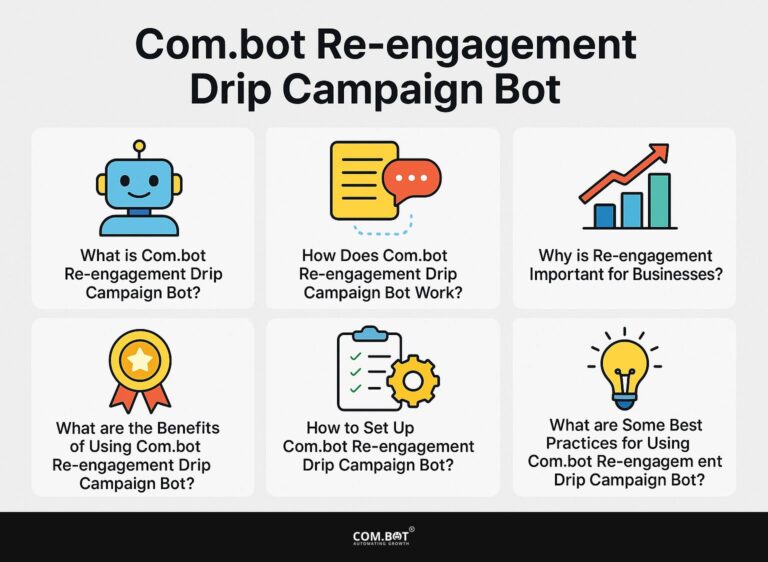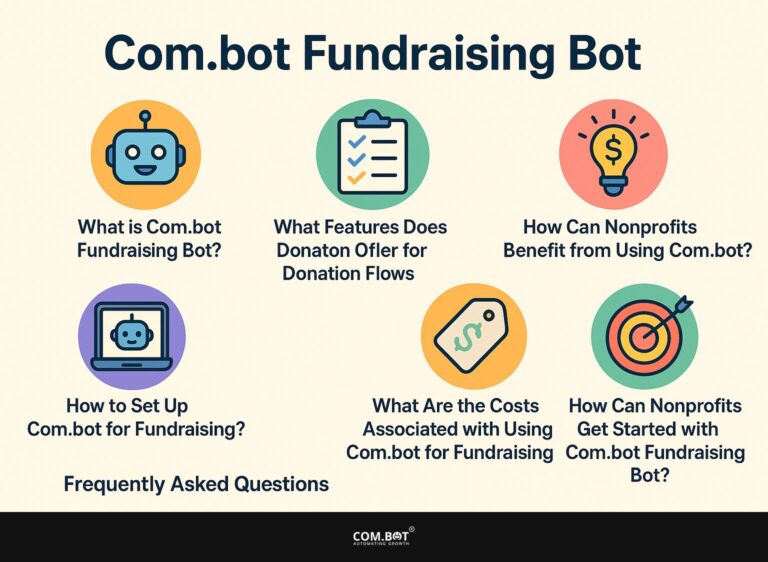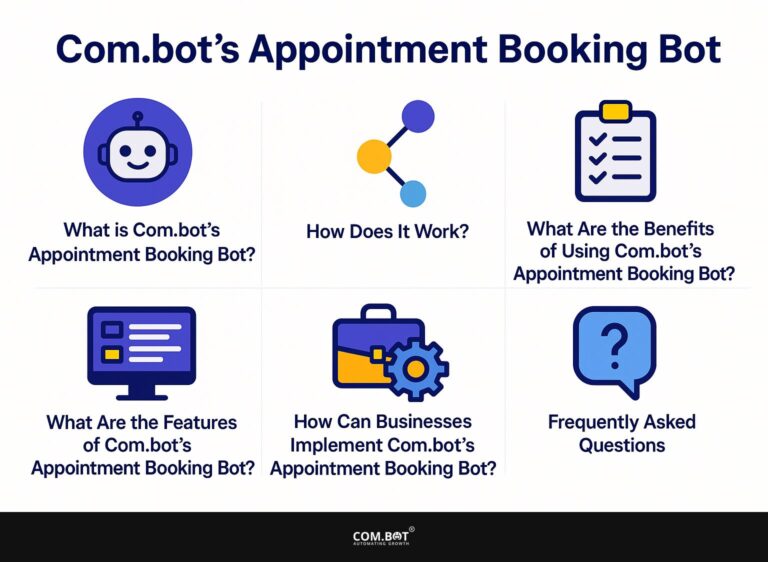Com.bot GDPR & CCPA Compliant Bot
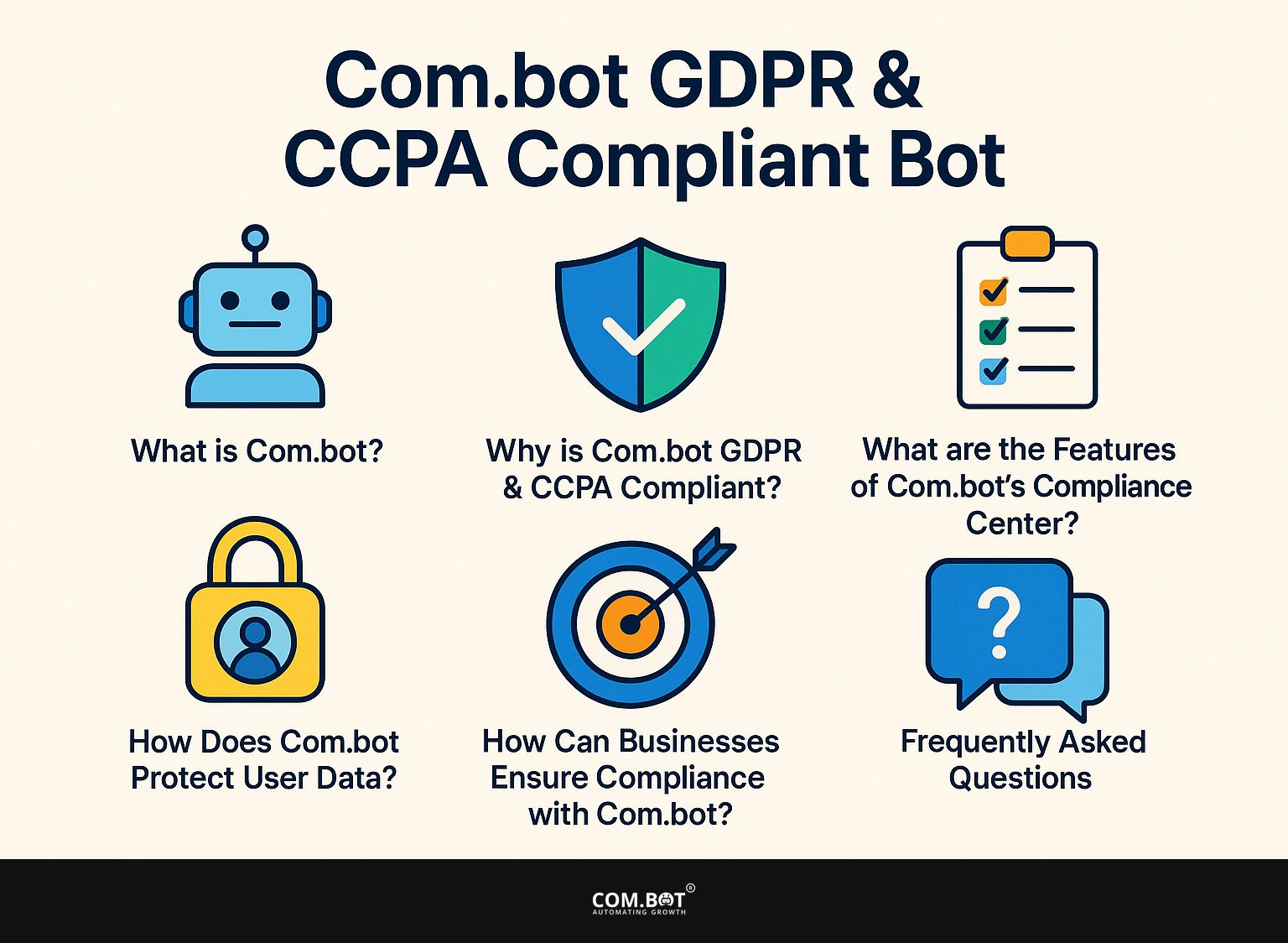
Navigating the complexities of data protection regulations like GDPR and CCPA can be daunting for businesses, but Com.bot offers a seamless solution. This article explores what Com.bot is and how it supports following these important rules.
Learn about its innovative features, including consent banners and data auto-purging, which help meet legal requirements and safeguard user data.
Join us as we unpack the essentials of Com.bot’s Compliance Center and its role in protecting privacy.
Key Takeaways:
- Com.bot is a tool that meets GDPR and CCPA rules, helping companies safeguard user information and follow data privacy laws.
- Com.bot’s compliance center offers features such as consent banners, opt-in logging, data auto-purging, and audit logs to meet the requirements of GDPR & CCPA.
- By implementing Com.bot, businesses can protect user data through secure storage and deletion options, while also monitoring and maintaining compliance with data privacy regulations.
- 1 What is Com.bot?
- 2 Why is Com.bot GDPR & CCPA Compliant?
- 3 What are the Features of Com.bot’s Compliance Center?
- 4 How Does Com.bot Protect User Data?
- 5 How Can Businesses Follow Rules with Com.bot?
- 6 Frequently Asked Questions
- 6.1 1. What is a Com.bot GDPR & CCPA Compliant Bot?
- 6.2 2. How does Com.bot follow GDPR & CCPA rules?
- 6.3 3. Why is it important for a chatbot to be GDPR & CCPA compliant?
- 6.4 4. Is Com.bot certified as GDPR & CCPA compliant?
- 6.5 5. Can I use Com.bot on my website if I operate in the European Union or California?
- 6.6 6. How does Com.bot protect user data?
What is Com.bot?
Com.bot is a tool for managing consent that helps companies follow data protection laws like the General Data Protection Regulation (GDPR) and the California Consumer Privacy Act (CCPA). It helps businesses handle user privacy well by showing consent banners on their websites, making sure personal data is handled according to legal rules.
Com.bot also manages data retention and deletion rules, providing an important tool for companies to handle personal information properly, comply with laws, and build trust with people in California and elsewhere.
Why is Com.bot GDPR & CCPA Compliant?
Com.bot is known for meeting GDPR and CCPA standards because it is built to protect user privacy and handle personal data responsibly.
It uses clear consent methods to show that organizations have a legal reason for data processing. This is important for businesses trying to follow data protection rules, build trust with users, and comply with laws like the General Data Protection Regulation and the California Consumer Privacy Act.
1. What are the Requirements of GDPR & CCPA?
The General Data Protection Regulation (GDPR) and the California Consumer Privacy Act (CCPA) establish critical requirements aimed at safeguarding user privacy rights and protecting personal information.
Both regulations mandate that organizations obtain explicit consent before collecting or processing personal data, clearly communicate their privacy policies, and provide users with the ability to access, modify, or delete their data. GDPR focuses on allowing individuals to move their data and delete it, while the CCPA makes sure people in California know their rights about how companies collect and use their data.
Besides these basic principles, businesses must put strong security measures in place to protect user data from breaches, which helps keep consumer trust. They must also establish mechanisms to facilitate user requests for their data rights, such as providing easy-to-use tools for exercising the right to access and portability.
Not following GDPR or CCPA can lead to large penalties and legal problems, pushing companies to take active steps in managing data. This involves creating clear internal rules, doing regular checks, and teaching employees to follow privacy rules. This protects customers and improves the organization’s reputation in the market.
2. How Does Com.bot Satisfy GDPR & CCPA Requirements?
Com.bot effectively satisfies the requirements of GDPR and CCPA through its innovative consent management features, enabling organizations to collect explicit consent from users seamlessly and transparently. By including consent banners, users are told about how their data is collected and handled, meeting the main rules of both regulatory systems.
Com.bot offers detailed audit logs and user data management tools, helping organizations follow GDPR and CCPA rules and manage user privacy rights. For instance, in a practical scenario where a marketing platform uses Com.bot, the consent banner can be customized to display clear options for users to either opt-in or opt-out of data sharing, catering to their individual preferences and legal rights.
When a user asks to see their stored data or wants their information deleted, the strong logging features in Com.bot let organizations find and handle this data fast. This helps them respond on time and meet legal deadlines. This increases customer confidence and reduces the chance of facing fines for not following rules.
What are the Features of Com.bot’s Compliance Center?
The Compliance Center of Com.bot provides effective tools that help organizations follow data protection rules like GDPR and CCPA. These tools help manage consent and handle user data properly.
Important features include:
- Consent banners that tell users about data collection
- Detailed records of user consent choices
- Automatic data removal systems that follow retention rules
- Audit logs that help organizations show they are following the rules and answer data questions
Together, these features help organizations stay clear and build trust with users about how their personal data is handled.
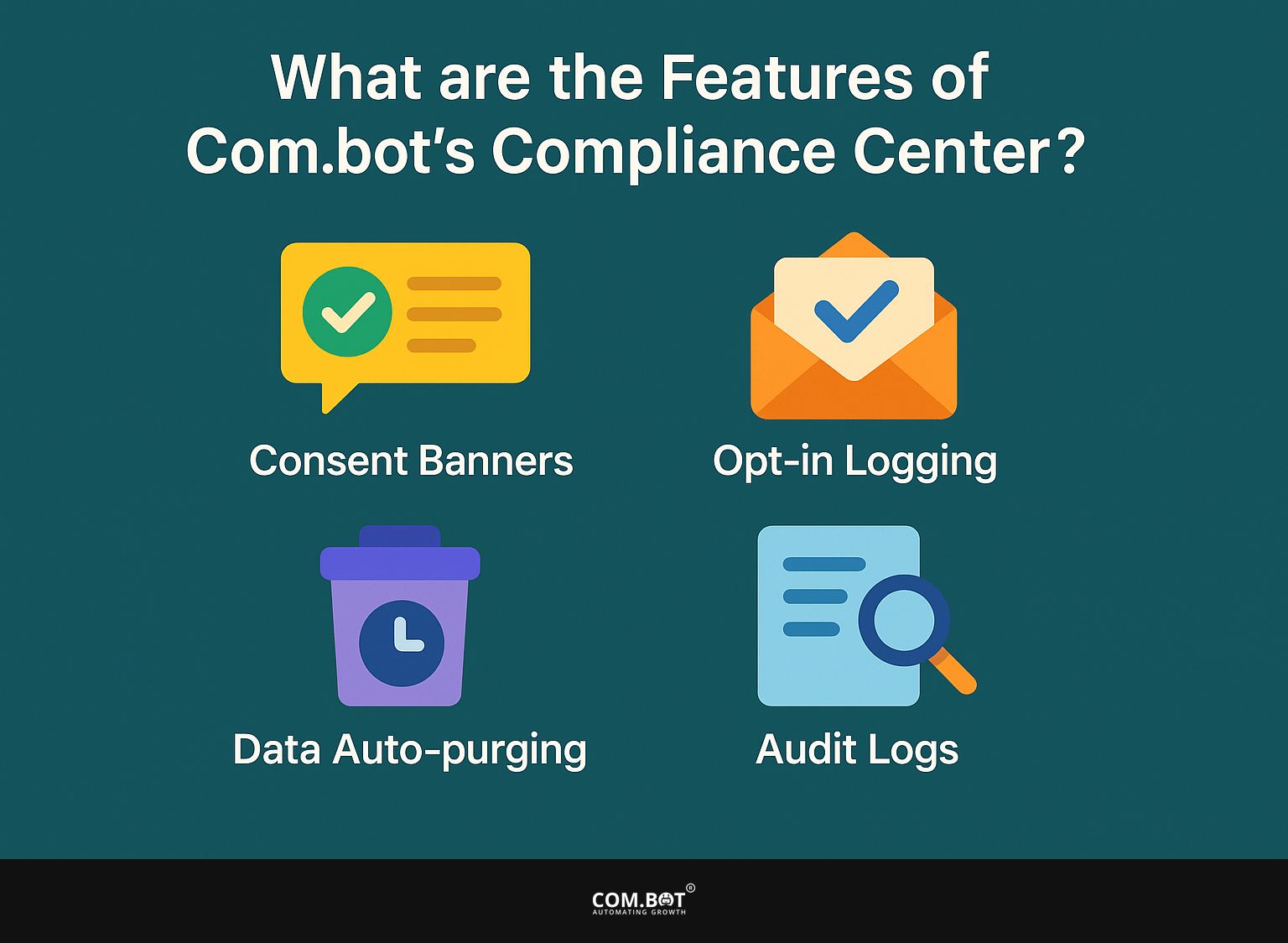
1. Consent Banners
Consent banners are a fundamental feature of Com.bot, designed to inform users about data collection practices and obtain their explicit consent in compliance with GDPR and CCPA. These banners are customizable, allowing organizations to tailor their message and appearance, ensuring that users are fully aware of their rights regarding personal data.
By integrating consent banners into their websites, organizations can create a transparent environment that highlights their commitment to user privacy rights and compliance with relevant data protection laws. The importance of these banners cannot be understated; they serve as a critical interface between users and organizations, ensuring that individuals have control over their personal information.
Effective implementation involves adhering to best practices such as providing clear choices for users and offering detailed explanations of data usage. Customizing the design to match the organization’s branding helps in gaining user trust. Consent banners meet legal requirements and help create openness, allowing users to decide how their data is used.
2. Opt-in Logging
Opt-in logging is an important part of Com.bot that tracks user agreement in detail, helping organizations handle user data properly to meet GDPR and CCPA rules. By tracking user preferences, businesses can demonstrate that consent was obtained explicitly, providing a legal basis for data processing while respecting user privacy rights.
This feature helps organizations follow rules and makes it easy for them to find and handle user consent records, improving how they manage data. For example, an online store can use opt-in logging to make sure customers agree to get marketing emails and custom offers.
By maintaining logs of these preferences, the platform can quickly respond to customer requests regarding their data, such as the ability to withdraw consent at any time.
Similarly, a mobile app that collects location data can use this feature to document users’ clear agreements to share their information, ensuring openness and trust. As companies give more importance to user consent, accurately recording and handling consent information forms a solid foundation for lasting customer relationships and compliance.
3. Data Auto-purging
Data auto-purging is a key function of Com.bot. It automatically deletes personal data based on set retention rules, helping meet GDPR and CCPA standards. This feature helps organizations reduce the risks linked to data leaks and protect user privacy by not keeping personal data longer than needed.
By automating data purging processes, businesses can effectively manage their data lifecycle and demonstrate accountability in their data handling practices. Having strict retention rules helps simplify data management, reduce storage costs, and improve system performance.
Organizations should regularly review and adjust their data retention strategies based on legal and operational requirements, as well as industry best practices. Regular training sessions and updates for employees on these policies can help create a workplace where following rules is the norm.
Using automatic data deletion helps organizations safeguard their own security and the confidential information of their users.
4. Audit Logs
Audit logs are an essential part of Com.bot’s Compliance Center. They provide organizations with detailed records of data handling activities, which are important for showing compliance with GDPR and CCPA. These logs capture essential information about user consent and data handling practices, providing transparency and accountability in how personal data is managed.
Keeping accurate audit records helps organizations quickly handle data issues, guard user privacy, and lower the chance of breaking compliance rules due to data breaches. These detailed logs let organizations monitor specific actions and changes to important information, supporting strong compliance measures.
To keep these logs well-maintained, check them often for accuracy and completeness. Also, store them securely to prevent unauthorized access. Organizations should install systems that create logs automatically and frequently, simplifying the compliance process.
By knowing how to use this important documentation well, businesses can improve their accountability and build more trust with users who are more aware of their data rights.
How Does Com.bot Protect User Data?
Com.bot protects your data by using a range of security methods and following rules like GDPR and CCPA. Com.bot protects your personal information by using secure data management practices to prevent unauthorized access or leaks.
This focus on data protection helps maintain your privacy, builds trust between companies and their users, and supports their compliance with regulations. Worth exploring: Com.bot Compliance Training Bot, which further enhances understanding and adherence to these important standards.

1. What Data Does Com.bot Collect?
Com.bot collects essential data that includes personal information provided by users, such as names, email addresses, and preferences related to consent management. We collect data openly and follow GDPR and CCPA rules. Users are told what information is gathered and how it will be used.
Com.bot helps organizations handle personal data well and build trust by prioritizing user approval and privacy. Along with basic details, the platform may gather information on user interactions, such as usage patterns and preferences, which can help tailor experiences and improve service delivery.
Com.bot recognizes the importance of both user rights and convenience, allowing individuals to easily access, correct, or delete their data if desired. This forward-thinking method gives users control and also shows Com.bot’s dedication to ethical handling of data.
Knowing these rights is important because it gives people the information they need to manage their data and encourages openness.
2. How is User Data Stored and Secured?
User data collected by Com.bot is kept safe with strong encryption techniques and strict security measures, following GDPR and CCPA rules. This secure data storage approach protects personal information from potential breaches and unauthorized access, addressing critical concerns regarding data security.
Com.bot focuses on keeping user data safe, helping organizations feel secure and building trust with users about their privacy rights. The company uses advanced encryption methods to make the information unreadable to anyone without permission, which improves the security of data storage.
Access controls are strictly enforced, allowing only authorized personnel to interact with sensitive information, which reduces the risk of insider threats. These thorough security measures comply with strict rules and demonstrate the company’s commitment to data safety, building user trust online.
With personal data breaches posing serious risks to reputations, Com.bot’s approach offers strong protection for users and collaborating organizations.
3. How Can Users Request Their Data to be Deleted?
Users can easily request the deletion of their personal data through Com.bot, which facilitates compliance with GDPR and CCPA mandates regarding user rights. This process usually requires filling out a form or using a specific user interface, allowing users to know their rights about how data is handled.
Com.bot helps users manage their personal information, showing its dedication to privacy and following data protection laws. To initiate a deletion request, users simply need to fill out the form with their details and specify the information they wish to have removed.
Com.bot’s job is important. It quickly handles these requests and makes sure users get timely updates on their request status. Knowing user rights in data protection laws is important because companies must follow these requests within a set period.
For organizations, best practices include maintaining clear communication, providing accessible forms, and training staff to handle requests diligently, all of which contribute to a stronger, trust-based relationship with users.
How Can Businesses Follow Rules with Com.bot?
Businesses can follow GDPR and CCPA rules by adding Com.bot features into their data handling processes. This involves changing consent banners, setting clear rules for how long data is kept, and using audit logs to keep track of compliance activities.
Organizations should also teach their teams about data protection rules and explain how Com.bot can help with these efforts, promoting responsibility and openness in handling user data. Related insight: Com.bot Compliance Training Bot offers tools that can enhance your team’s understanding of data protection requirements.

1. What Steps Should Businesses Take Before Implementing Com.bot?
Before starting to use Com.bot, businesses should carefully review their current data handling methods and find areas that need better solutions to follow GDPR and CCPA rules. This assessment should include reviewing existing consent mechanisms, data retention policies, and user privacy rights to align with regulatory requirements effectively.
Organizations should involve people from different departments to fully grasp how Com.bot can help them meet compliance requirements. Simultaneously, teaching staff how Com.bot works and how it can help them is important, so they can use it to its full potential. Training sessions should cover both usage and the importance of following rules, encouraging responsibility within the organization.
Setting specific compliance goals that match the organization’s aims will show how Com.bot’s features fit with the business strategy. By building this connection, decision-makers can understand how the integration improves regulatory compliance and increases efficiency and creativity.
2. How Can Businesses Monitor and Maintain Compliance with Com.bot?
Businesses can monitor and keep track of compliance using Com.bot’s built-in auditing tools. These tools record consent and data processing activities, offering a clear view of their compliance status. Regularly reviewing these audit logs allows organizations to identify potential gaps in compliance and address them proactively, ensuring that user rights are respected under GDPR and CCPA.
Ongoing training and awareness programs can reinforce the importance of data protection within the organization. To improve these strategies, organizations should set up regular compliance checks and make this part of their overall risk management plan.
Using Com.bot’s reporting tools can help produce information and patterns related to compliance as time passes. Involving employees with hands-on workshops and online courses can build a workplace environment that values data responsibility.
Getting input from employees can improve training materials, making them easier to understand and use. Sharing compliance updates helps everyone stay informed and ready for regulation changes.
3. What Are the Consequences of Non-Compliance with GDPR & CCPA?
Not following GDPR and CCPA rules can result in major problems for companies, such as large fines, legal issues, and harm to their reputation. GDPR can lead to penalties as high as 4% of yearly worldwide revenue or EUR20 million, depending on which is more. Violating CCPA regulations can result in financial penalties and legal actions from affected individuals.
Beyond financial repercussions, non-compliance can erode user trust, leading to loss of customer loyalty and potential data breaches as businesses fail to protect personal information adequately. The stakes are undeniably high, as many organizations have faced harsh penalties for failing to meet these regulations.
For instance, British Airways was fined GBP20 million under GDPR after a significant data breach compromised the personal information of over 400,000 customers. Similarly, in a notable CCPA case, a prominent data analytics firm was held liable for failing to honor consumer requests regarding their data, resulting in significant legal costs and a tarnished reputation.
These incidents show that following data protection laws is legally required and important for keeping a company’s integrity and trustworthiness in a competitive market.
Frequently Asked Questions
1. What is a Com.bot GDPR & CCPA Compliant Bot?
A Com.bot GDPR & CCPA Compliant Bot is a chatbot that is designed and developed to comply with the regulations set forth by the General Data Protection Regulation (GDPR) and the California Consumer Privacy Act (CCPA).
2. How does Com.bot follow GDPR & CCPA rules?
Com.bot includes consent banners, records user approvals, and automatically deletes data according to retention rules to comply with GDPR and CCPA laws. It also provides audit logs in its compliance center for transparency and accountability.
3. Why is it important for a chatbot to be GDPR & CCPA compliant?
It is important for a chatbot to be GDPR & CCPA compliant to protect the privacy and data of its users. Non-compliance with these regulations can result in hefty fines and damage to the reputation of the company.
4. Is Com.bot certified as GDPR & CCPA compliant?
There is no official certification for GDPR and CCPA compliance, but Com.bot adheres to the rules and regulations of these laws to stay compliant.
5. Can I use Com.bot on my website if I operate in the European Union or California?
Yes, Com.bot follows GDPR and CCPA rules, allowing it to be used on websites in the European Union or California.
6. How does Com.bot protect user data?
Com.bot uses industry-standard security measures to protect user data, including encryption and secure data storage. It follows recommended methods for data privacy and frequently checks and changes its rules to meet GDPR and CCPA standards.


